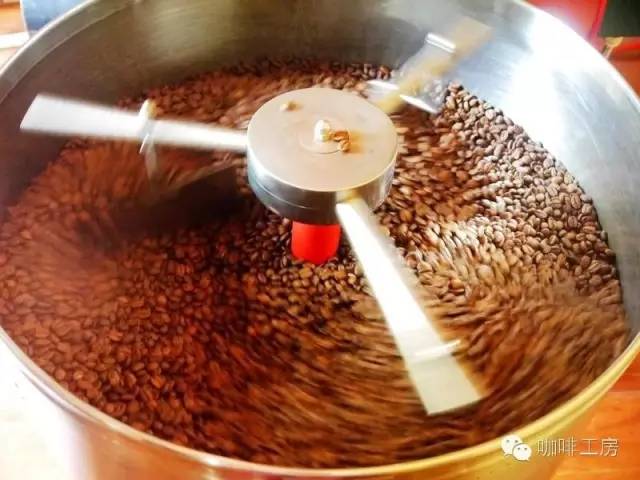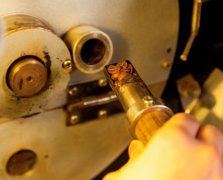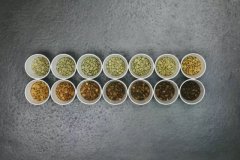Explanation on the baking process and change of small coffee roaster the essential information of small roasting coffee shop

Professional coffee knowledge exchange more coffee bean information please follow the coffee workshop (Wechat official account cafe_style)
Professional coffee roasting | is coffee roasting too complicated? A picture teaches you about the baking process.
Coffee roasting refers to the process in which raw coffee beans are transformed into ripe beans by heating in a roaster.
How well should the coffee be roasted? What's going to change? What beans are suitable for shallow baking and which beans are suitable for deep baking? This is a question often asked by many people I meet.
In fact, coffee beans go through a series of physical and chemical changes in the roasting process, which is extremely tedious and complicated. Different roasting processes and conditions will lead to different results of the same kind of coffee beans.
Changes in the roasting process of coffee
Generally speaking, fresh coffee beans are turquoise, and the color will gradually become lighter as the water content decreases over time.
(I) dehydration
When the roaster is preheated to a certain temperature, we slowly heat the raw coffee beans in the roaster, and the water between the cells in the beans becomes lighter and lighter because of the heat, and the color of yellow dried straw becomes lighter and lighter. The smell of beans has also changed from grass to toast, and the dehydration stage is over.
(2) to accelerate the fire
At this time, although the water between the cells has roughly evaporated, the water in the cell wall still exists. As the roaster continues to heat the water in the coffee bean cells and gradually absorbs heat and expands, the bean temperature rises slowly at this time. In order to make the following series of chemical reactions proceed smoothly, it is a very important key to heat up the bean temperature at this time.
(3) one explosion to reduce fire
When the bean continues to absorb the water in the coffee bean cell because the endothermic evaporation causes a series of chemical changes in the cell and produces a large amount of carbon dioxide, until the cell wall can not withstand the internal pressure to burst, the bean also changes from endothermic to exothermic so that the temperature rises rapidly. At this time, it is necessary to be able to immediately reduce the fire in order to strain the soaring bean temperature, otherwise the rapidly rising temperature will make the beans follow a series of chemical changes too fast and the transformation is not complete, which will cause bitter degradation and aromatic substances polymerization and other actions do not have enough time to react, that pot of beans will be destroyed, so the regulation and control at this stage is very important.
(4) second explosion regulation
Coffee beans after an explosion to release a large amount of heat and adjust the fire will have a quiet period of 2 minutes and then slowly begin to absorb heat, at this time do not heat up with the fire, but can not lose temperature or stagnation, so the need for moderate adjustment of the heat source so that the temperature rise steadily to prepare for the arrival of the second explosion. When the cells in the coffee beans once again cannot withstand internal pressure and burst and produce a second burst, the sound of the second explosion is not as strong as that of the first explosion is presented in a small and rapid way. The firepower after the second explosion should also be carefully adjusted because the caramelized coffee beans are more fragile and can no longer stand too much firepower.
(5) Lower beans
When the coffee beans reach the roasting level we set, the beans are released from the oven, and the internal temperature of the coffee beans is still very high and constantly changing. Therefore, the beans must be cooled quickly after dropping the beans, otherwise continuous changes in the beans may make the baking deeper.
.
Important Notice :
前街咖啡 FrontStreet Coffee has moved to new addredd:
FrontStreet Coffee Address: 315,Donghua East Road,GuangZhou
Tel:020 38364473
- Prev

Coffee bean roasting process shows coffee talent teaching coffee roasting experience
Professional coffee knowledge exchange more coffee bean information please follow the coffee workshop (Wechat official account cafe_style) professional coffee roasting | coffee roasting is too complicated? A picture teaches you that good roasting can enhance the local conditions and taste of coffee beans. If the roasting is too bitter or not ripe, the coffee will lose its taste. Have rich baking experience
- Next

Coffee bean roasting process and color change-diagram of coffee roasting process
Professional coffee knowledge exchange more coffee bean information please follow the coffee workshop (Wechat official account cafe_style) professional coffee roasting | coffee roasting is too complicated? A picture teaches you the roasting process and color changes of coffee beans. Coffee beans are good. 1. When studying the roasting degree of coffee beans, the degree of roasting can be judged by sound, color, and aroma. Its color
Related
- Beginners will see the "Coffee pull flower" guide!
- What is the difference between ice blog purified milk and ordinary milk coffee?
- Why is the Philippines the largest producer of crops in Liberia?
- For coffee extraction, should the fine powder be retained?
- How does extracted espresso fill pressed powder? How much strength does it take to press the powder?
- How to make jasmine cold extract coffee? Is the jasmine + latte good?
- Will this little toy really make the coffee taste better? How does Lily Drip affect coffee extraction?
- Will the action of slapping the filter cup also affect coffee extraction?
- What's the difference between powder-to-water ratio and powder-to-liquid ratio?
- What is the Ethiopian local species? What does it have to do with Heirloom native species?

